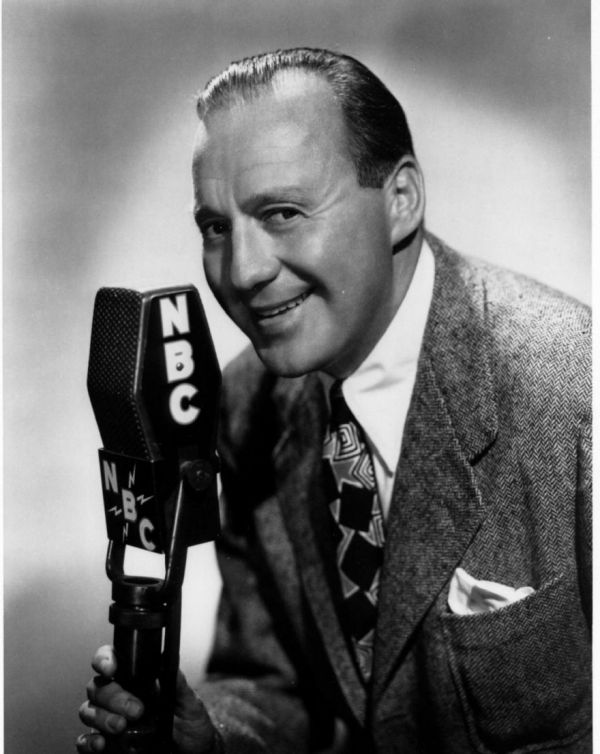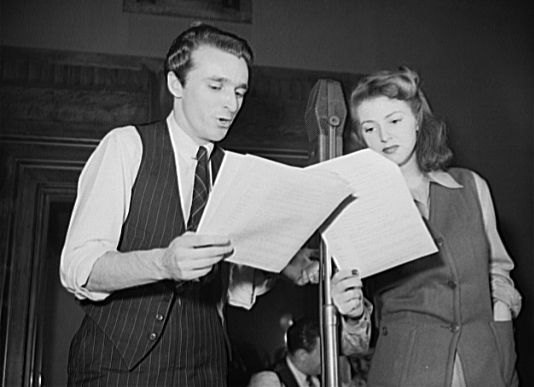Long before videos or DVDs, even before television, families used to
gather nightly for their favorite programs. They'd sit around the
family radio and listen to popular comedies, dramas, and variety shows. Here's how it all started.
LISTEN TO THIS
Have you ever heard this joke
about Alexander Graham Bell? "When he invented the phone, who did he
talk to? He was the only guy with a phone!" It was the same with radio
when it started out. The only people who owned radios were hobbyists who
built their own sets. There were no radio stations as we now know them
-these radio amateurs, or "hams," built their own transmitters and
receivers so they could talk to each other. They were enthusiastic about
their hobby and spent a lot of time talking on their radios: what kind
of equipment they had, how much power they were using, and how well they
were receiving each other's signals. But even dedicated hams got a
little tired of the conversation after a while.

One
day in October 1919, Frank Conrad, a ham in Wilkinsburg, Pennsylvania,
got so bored with talking that he pushed a phonograph up to his
microphone and played a record of the Stephen Foster song "Old Black
Joe." In the past, Conrad's transmissions had always been directed
toward one particular person. This time, he sent "Old Black Joe" out
over the air waves to no one in particular …and made radio history. He
called his new form of communication "broadcasting."
AND NOW A WORD FROM OUR SPONSOR
Conrad continued to

play records over the air and was soon deluged with letters from other
radio operators thanking him an requesting specific songs. He couldn't
honor them all, so instead he announced he would play records on
Wednesday and Saturday nights, from 7:30 to 9:30 PM. After he'd gone
through his own record collection a few times, a local record store
offered to lend him more. Conrad returned the favor (and made history
again) by telling his listeners that the records were for sale at the
store. It was the first commercial ever aired.
AN INDUSTRY IS BORN
Over
time Conrad's regular broadcasts became so popular that the local
Joseph Horne department store began selling $10 ready-made crystal radio
receivers to people who wanted to listen to Conrad's broadcasts but
didn't want to build their own radios. The store advertised its radios
in local newspapers.
Taking out newspaper ads might not sound
like a very big deal, but it made all the difference. Although a few
other people had played music over the air even earlier than Conrad
(Reginald Fessenden, the man credited with inventing AM radio, played
Christmas music and read Bible verses to ships at sea on Christmas Eve,
1906), nothing had come of those early broadcasts. Conrad worked as an
engineer at Westinghouse, a company that manufactured electrical
equipment for power plants, and he had been urging his company to get
into the radio broadcasting business. But it wasn't until Harvey P.
Davis, a Westinghouse vice president, saw the crystal radios advertised
in the paper that someone in a position to do something about it finally
realized that radio had potential far beyond the small pool of hams who
built their own sets.
ON THE AIR
Davis
figured the big money in radio would come from manufacturing and selling
receivers, but he also knew that people had to have more to listen to
than Conrad's records two nights a week. He decided that Westinghouse
should build its own radio station, one that would broadcast every
night.
The 1920 presidential election was less than a month
away- why not start the new service with a bang, by broadcasting the
results of the race between Warren G. Harding and James M. Cox? Davis
put Conrad to work building a radio station on the roof of the
Westinghouse plant in east Pittsburgh; he finished with time to spare.
The station received its license -with its call letters, KDKA- on
October 27, 1920, and began broadcasting election returns at 6PM on
election day, November 2. Listening audience: between 500 and 1,000
people. During the broadcast, Conrad stayed home and manned his own
station, ready to take over in case KDKA went off the air. But it didn't
-the broadcast continued without a hitch until noon the following day
(Harding won in a landslide). The station is still on the air today.
 THE RADIO CRAZE
THE RADIO CRAZE
Radio
started slowly at first and then exploded. In 1921, only eight more
radio stations received licenses to broadcast; by the end of 1922
another 550 stations around the country were on the air. Now that there
was something to listen to, Americans began buying radios as fast as
manufacturers could make them. Sales went from almost none in 1920 to
$60 million in 1922; they more than doubled in 1923 and doubled again in
1924, and kept climbing after that. By 1926 radios were a $500 million
business.

Another
important development paralleled the tremendous growth in radio sales:
the linking of individual radio stations- first into regional
"chains," as they were called, and them into national networks.
AT&T started the trend in 1923 when engineers figured out how to
link the company's 18 radio stations by telephone lines so that a
program originating in one station could be broadcast simultaneously
over every station in the network. By 1924, AT&T was broadcasting
from coast to coast.
In 1926, AT&T sold its radio stations to
the Radio Corporation of America (RCA), which combined them with its own
stations to form the National Broadcasting Company (NBC). The founding
of NBC is considered the start of the golden age of radio.
The
Columbia Broadcasting System (CBS) network was formed in 1927, and a
third network -Mutual Broadcasting- went on the air in 1934. In the
early 1940s, an anti-trust decision by the Supreme Court forced NBC to
split into two independent companies. One part was sold off to
Lifesavers president Edward J. Noble in 1943 and was renamed the
American Broadcasting Company (ABC).
MORE THAN JUST MUSIC
Radio
offered numerous advantages over phonographs in 1920s: Listeners
weren't limited to the records in their own collection, and they didn't
have to get up every five minutes to flip the record over and wind the
record player back up. (Long playing, or "LP" records, which had about
30 minutes of playing time on each side instead of four and a half
minutes, weren't introduced until 1948.) Even better: radio broadcasts
were
free. Yet as early as 1926, opinion polls began showing
that listeners were hungry for something to listen to besides music. The
networks responded by developing a variety of shows for every member of
the family.
WHAT WAS ON
 Comedies:
Comedies:
Comedy shows were some of the earliest hits on radio -it was easy for
vaudeville stars like Jack Benny, Eddie Cantor, and the husband/wife
teams of George Burns and Gracie Allen to move their acts to the new
medium. At first these comedians did their usual standup routines, but
over time they pioneered the "situation comedy" format that's still
being used on TV today. A situation is set up at the beginning of the
episode -Jack Benny has to go to the doctor, for example- then it's
milked for jokes for the rest of the show.
Kiddies Shows:
These shows were on in the afternoon when kids got home from school, in
the early evening, and on Saturday mornings. Established movie and
comic-strip characters like Superman and Little Orphan Annie were
quickly adapted for radio. In later year the trend reversed itself, as
characters created for radio -like Captain Midnight, Sergeant Preston of
the Yukon, and Jack Armstrong, the All-American Boy- moved on to comic
books, movies, and eventually television.
Soap Operas:
Soaps appealed primarily to housewives, and dominated the daytime. The
soap opera format came about only by chance in 1932, when NBC moved a
show called
Clara, Lu 'n' Em from its evening prime time slot to the middle of the day because that was the only place for it in the schedule.
Clara, Lu 'n' Em was
more of a satire than a soap, but it did so well that NBC began
programming other shows for women during the day. Soaps proved to be the
most popular shows; by 1940 the four networks offered more than 60
hours of soap operas a week.
 Dramas:
Dramas:
One of the nice things about radio is that you can transport the
listener anywhere using only sound effects. You want to tell a story
about space colonists on Mars? About cops in L.A.? Maintaining order in
Dodge City, Kansas? You don't need fancy costumes or sets -you just need
the right background sounds. Police and detective shows came early to
radio. They were easy to produce because they were dialogue-heavy,
filled with characters who spent a lot of time standing around trying to
solve crimes. And they were polar with audiences.
Surprisingly,
science fiction shows and Westerns targeted at adults appeared
relatively late in radio and never really caught on. All four networks
introduced science fiction series for adults in the 1950s, but only two
of them,
2000 Plus (Mutual 1950-52) and
X Minus One (NBC, 1955-58) lasted longer than two years.
Gunsmoke,
the first adult-themed Western, didn't appear until 1952, but it fared
much better than science fiction shows. It became one of the most
popular programs on the air and ran until the summer of 1961. (The TV
version ran for twenty years, from 1955 to 1975, making it the
longest-running drama in history.)
SIGNING OFF

What
ended the Golden Age of Radio? TV, of course. In retrospect, it's
amazing that radio lasted as long as it did -both NBC and CBS began
making experimental television broadcasts from their New York stations
in 1939, and both stations were issued commercial licenses in 1941. Were
it not for World War II, TV might have swept the country over the next
few years. But when the United States entered the war, further
development was halted as the stations cut their broadcasts back to
nothing and TV manufacturers switched over to making electrical
equipment for the war effort.
AS SEEN ON TV
When
World War II ended in 1945, fewer than 10,000 American households had a
television, and most of the sets were in the New York area. The
industry got a boost in 1947, when the World Series was broadcast on
television for the first time. It's estimated that of the nearly 4
million people who watched the game, at least 3.5 million of them
watched on sets in their neighborhood taverns. Many of these patrons
then went out and bought TVs for their own homes -and when curious
neighbors came over to watch, they wanted TVs, too. The TV craze was on.
BY 1951 television broadcasts were available coast to coast and
six million homes had TVs. People were buying them as fast as
manufacturers could make them. By the end of the decade more than 60
million homes had TVs, and as American abandoned their radios in favor
of television, so did advertisers, and so did the stars. The most
successful radio shows like
Gunsmoke and
The Jack Benny Show moved to TV (
Gunsmoke stayed on radio for a time as well); less successful shows just went off the air.

As
the big advertising dollars left radio, big-budget shows became
impossible to air. Many radio stations with hours of programming to fill
and little money to do it went back to what radio had been in the
beginning: a single person, sitting alone in a booth, playing records
for anyone who happened to be listening.
THEY'RE BAAACK
Today
the classic shows of the Golden Age of Radio are largely absent from AM
and FM radio, but thanks to satellite radio and the internet, they're
more widely available now than they've been since they originally aired.
Both XM Radio and Sirius offer channels that play classic radio shows
24 hours a day; and you can buy collections of old shows in bookstores
or download them on iTunes. If you've never heard them, you're in for a
treat.
















 play records over the air and was soon deluged with letters from other
radio operators thanking him an requesting specific songs. He couldn't
honor them all, so instead he announced he would play records on
Wednesday and Saturday nights, from 7:30 to 9:30 PM. After he'd gone
through his own record collection a few times, a local record store
offered to lend him more. Conrad returned the favor (and made history
again) by telling his listeners that the records were for sale at the
store. It was the first commercial ever aired.
play records over the air and was soon deluged with letters from other
radio operators thanking him an requesting specific songs. He couldn't
honor them all, so instead he announced he would play records on
Wednesday and Saturday nights, from 7:30 to 9:30 PM. After he'd gone
through his own record collection a few times, a local record store
offered to lend him more. Conrad returned the favor (and made history
again) by telling his listeners that the records were for sale at the
store. It was the first commercial ever aired. 

 Comedies:
Comedy shows were some of the earliest hits on radio -it was easy for
vaudeville stars like Jack Benny, Eddie Cantor, and the husband/wife
teams of George Burns and Gracie Allen to move their acts to the new
medium. At first these comedians did their usual standup routines, but
over time they pioneered the "situation comedy" format that's still
being used on TV today. A situation is set up at the beginning of the
episode -Jack Benny has to go to the doctor, for example- then it's
milked for jokes for the rest of the show.
Comedies:
Comedy shows were some of the earliest hits on radio -it was easy for
vaudeville stars like Jack Benny, Eddie Cantor, and the husband/wife
teams of George Burns and Gracie Allen to move their acts to the new
medium. At first these comedians did their usual standup routines, but
over time they pioneered the "situation comedy" format that's still
being used on TV today. A situation is set up at the beginning of the
episode -Jack Benny has to go to the doctor, for example- then it's
milked for jokes for the rest of the show. 
 What
ended the Golden Age of Radio? TV, of course. In retrospect, it's
amazing that radio lasted as long as it did -both NBC and CBS began
making experimental television broadcasts from their New York stations
in 1939, and both stations were issued commercial licenses in 1941. Were
it not for World War II, TV might have swept the country over the next
few years. But when the United States entered the war, further
development was halted as the stations cut their broadcasts back to
nothing and TV manufacturers switched over to making electrical
equipment for the war effort.
What
ended the Golden Age of Radio? TV, of course. In retrospect, it's
amazing that radio lasted as long as it did -both NBC and CBS began
making experimental television broadcasts from their New York stations
in 1939, and both stations were issued commercial licenses in 1941. Were
it not for World War II, TV might have swept the country over the next
few years. But when the United States entered the war, further
development was halted as the stations cut their broadcasts back to
nothing and TV manufacturers switched over to making electrical
equipment for the war effort.  As
the big advertising dollars left radio, big-budget shows became
impossible to air. Many radio stations with hours of programming to fill
and little money to do it went back to what radio had been in the
beginning: a single person, sitting alone in a booth, playing records
for anyone who happened to be listening.
As
the big advertising dollars left radio, big-budget shows became
impossible to air. Many radio stations with hours of programming to fill
and little money to do it went back to what radio had been in the
beginning: a single person, sitting alone in a booth, playing records
for anyone who happened to be listening. 






 We
propose to remedy this problem by suggesting that the standard unit of
fame be called the Lewinsky (Lw), where 1 Lewinsky is the number of web
pages that mention Monica Lewinsky. In this system, Earle Spamer has a
fame of 840 microLewinskys, while Jesus Christ has a fame of 7.6
Lewinskys.
We
propose to remedy this problem by suggesting that the standard unit of
fame be called the Lewinsky (Lw), where 1 Lewinsky is the number of web
pages that mention Monica Lewinsky. In this system, Earle Spamer has a
fame of 840 microLewinskys, while Jesus Christ has a fame of 7.6
Lewinskys.


